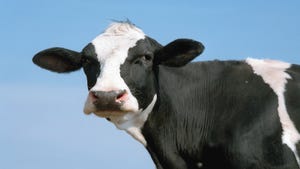Maybe seed corn companies ought to give away soil thermometers instead of caps and jackets. They may not get as much advertising value, but the farmer who gets one and uses it before planting corn may find enough value in it to remain a valued customer for life.
Related: When to plant corn: Waiting on the magic number of 55 degrees F
Those who are serious about timing corn planting and paying attention to soil temperatures often carry a soil thermometer. They may also look at the upcoming weather forecast.
Slow start: Both yellow corn and the soil thermometer gauge document that this field on Ken Simpson's corn field was off to a slow start in 2014. Photo courtesy of Scott Gabbard, Shelby County Extension ag educator.
If the soil temperature is borderline, say right at or just under 55 degrees F and a warm spell is expected, planting corn may be in order. If it's the same situation but several days of cloudy, cooler than normal temperatures are forecast, it may pay to hold off, even if you do sacrifice days on the calendar.
Planting corn "early" is relative and varies by conditions which definitely vary season by season.
One year ago Scott Gabbard watched a plot carefully on Ken Simpson's farm near Morristown. Simpson had agreed to put out field size plots with both Bob Nielsen and Jim Camberato for nitrogen trials, and with Kiersten Wise for fungicide trials. All three are Purdue University Extension agronomists.
While they picked corn planting dates carefully based on the weather, a cold, wet spell after planting lasted longer than expected. Gabbard documented with his camera that soil temperatures fell back after planting.
Gabbard also captured the yellow color of the corn that persisted during that cool, rainy, cloudy spell. If Simpson wished his corn was back in the sack at that point, no one could have blamed him.
The rest of the story, however, is that due to a nearly ideal pollinations season, that field recovered and not only hit average yield, it produced more than 220 bushels per acre. There was a day in late May when you likely could have bought the field for far less than 200 bushels per acre!
Don't overlook spring planter preparation – if you skip it, you could be subject to the bottom-line implications of not minding the details. For helpful tips, download our free report: Planter Preparation Tips: Best Practices for Minimizing Breakdowns this Spring
The moral of the story? Pay attention to soil temperatures when planting corn, but remember they are just one piece to the puzzle. Factor in other issues as well when deciding when to plant.
About the Author(s)
You May Also Like




